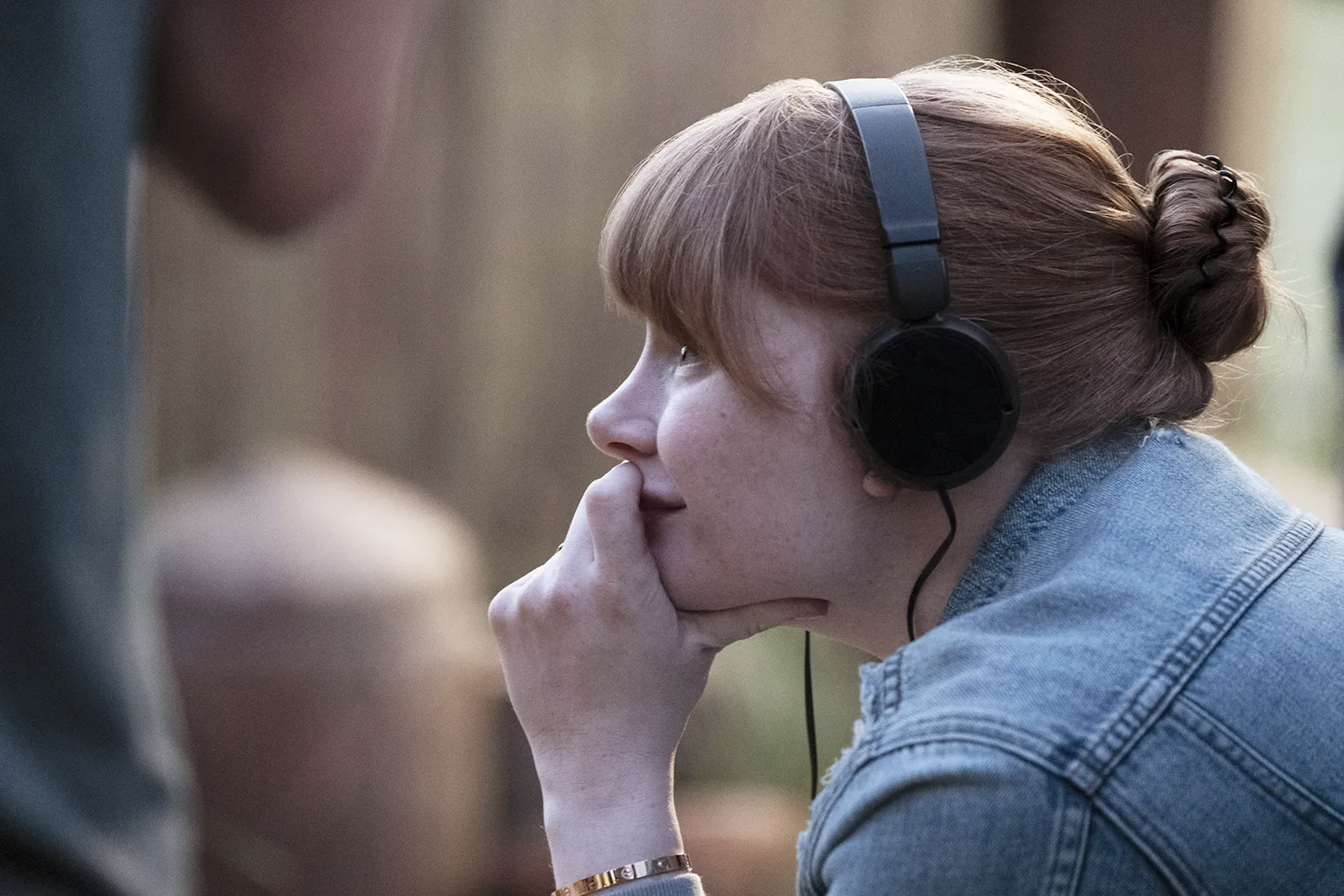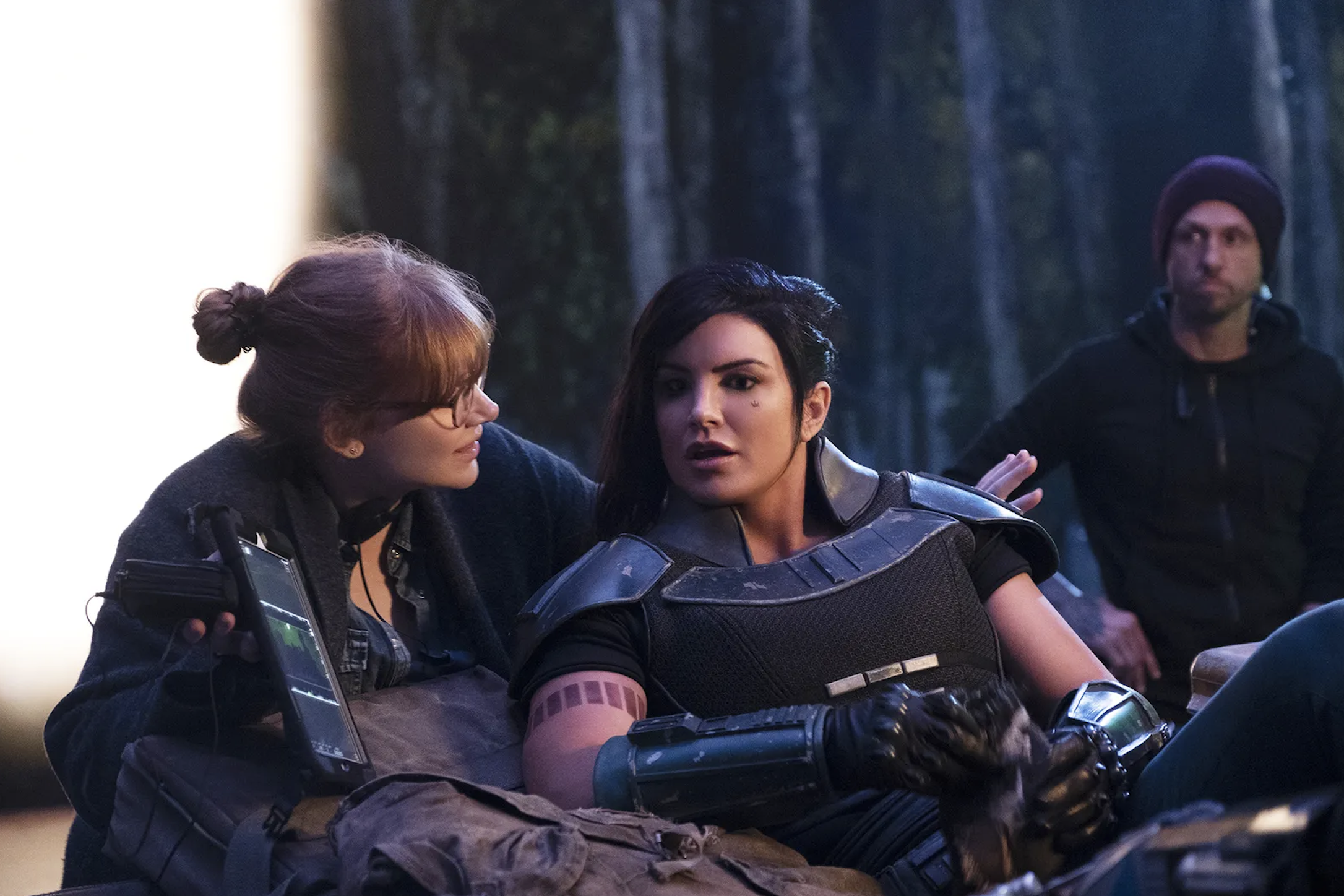Vanity Fair, June 3, 2022
Hundreds, if not thousands, of photographs exist of Bryce Dallas Howard: photos of her smiling on red carpets, of her being compared to her red-headed Hollywood doppelgänger and friend Jessica Chastain, or just candid looks into her work, her family, and the occasional throwback to her youth on social media.
There is one very specific photo of Howard, however, that I can’t help but bring up when we sit down to talk over Zoom. Calling from a bedroom hallway that doubles as her home office, the walls behind her wallpapered with dinosaurs (“I have a mural of the twin suns of Tatooine painted on the side of my house,” she says. “My dining room I call the [Hayao] Miyazaki dining room. It’s a forest like you’re in My Neighbor Totoro”), Howard studies the photo in question.
In it, Howard seems completely unaware she’s being photographed. She’s far too occupied watching a scene play out from her director’s chair on an episode of The Mandalorian. “When I’m directing—and a lot of directors are like this—it becomes a highly physical endeavor,” she says, laughing. “I love that, as an actor, when you feel the director behind the camera—when you can feel them be in that next moment, and you’re with them.”
The Mandalorian and its recent spinoff, The Book of Boba Fett, have boasted a who’s who of directorial talent, including Taika Waititi, Robert Rodriguez, and Peyton Reed, as well as creator Jon Favreau and executive producer Dave Filoni. But those series have also become a successful proving ground for up-and-coming filmmakers like Deborah Chow—who went from directing two season-one episodes of The Mandalorian to being given sole directorial responsibility for all six episodes of the highly anticipated limited series Obi-Wan Kenobi—and Howard herself.
Not that she’d necessarily describe herself that way. When prompted to talk about something she’s done or accomplished, Howard tends to get sidetracked, fawning instead over the talent of some other person or creative department she’s known or worked with. She is also well aware of who her father is—Oscar-winning director Ron Howard—and that everyone else knows who her father is too. It’s perhaps why her gratitude is so up front, like something you can actually reach out and touch.
Being a director has more or less always been a forgone conclusion for Howard. She spent her childhood and adolescence seeing Ron work, regularly watching him watch dailies (the recorded takes of a given day’s shoot) with his editor, director of photography, and even the lead actor to discuss what was and wasn’t working. “Getting to experience that was instrumental,” she says.
Although she knew she wanted to follow in his footsteps, Howard also took to heart her father’s advice: that if she wanted to make it in the theater and film industry, she couldn’t just be good at just one thing. As a result, she says, Howard started “spinning plates,” infiltrating various aspects of film production—including, of course, acting.
To her surprise, Howard started landing roles. “I remember thinking, Oh, my gosh, this is kind of a coup,” she says. Her big break came in 2003 when she performed as Rosalind in Shakespeare’s As You Like It at New York’s Public Theater, catching the attention of director M. Night Shyamalan. Without an audition, Shyamalan cast Howard as the lead in his 2004 film The Village.
But as she continued to appear in films by Lars von Trier, Kenneth Branagh, Sam Raimi, Clint Eastwood, and Colin Trevorrow, Howard never lost sight of her desire to direct—often choosing acting gigs as a means of gleaning techniques and the application of new technology. Howard was also putting her lessons to practical use, writing and directing a number of short films.
Despite all that, Howard’s goal wouldn’t become a reality until 2017, during the troubled production of Solo: A Star Wars Story. The standalone Star Wars film was being helmed by directors Phil Lord and Christopher Miller—until the two left the project, citing “creative differences” about halfway through principal photography. Ron Howard, who had acted for George Lucas in American Graffiti, directed Willow, and has said he was asked by Lucas to direct Episode I—The Phantom Menace, took over the job.
His daughter, naturally, saw a once-in-a-lifetime opportunity. “I had just finished Jurassic World: Fallen Kingdom. We were shooting in Pinewood [Studios], which is the same location where my dad was. And I went to him and said, ‘Please, can I shadow you on Solo? I feel unbelievably lucky and privileged for all the access that I have had in my life, but I’m asking right now for more. Please, please, please can I shadow you on Solo?’” After getting approval from the powers that be, Howard was granted access.
There, Howard was introduced to producer John Swartz, who was quickly making a name for himself working under Lucasfilm’s newly-minted president Kathleen Kennedy. Swartz would eventually invite Howard to take part in a workshop for young filmmakers where they could write, develop ideas, and be given exposure to some of the breakthrough technology at Lucas’s visual effects company, Industrial Light & Magic.
This is the part where things get a little fuzzy for Howard. “I’ll never really know,” she says. “I think my name got put on a list.” For whatever reason, in 2018, an email from Jon Favreau arrived in Howard’s inbox asking if he could talk to her about a project. “We got on the phone, and he talked through Star Wars and George, and what was incredibly meaningful about Star Wars and storytelling and sharing these really beautiful, inspiring sentiments,” recalls Howard. “And then he said, ‘I’ve written a series, and I’d love for you to take a look at it. You can come in and I’ll show you all the artwork and stuff, and we can talk about it and you can see if you’d be interested. And so then I read the pilot, and when it got to Baby Yoda, I was just like, What am I reading?!”
After gushing over the pilot for The Mandalorian, Howard was invited to Favreau’s office. Filoni was also in attendance. “It was like, I had the job,” she says. “I don’t think Jon had seen any of my short films. I don’t think he knew that I worked with Canon for years testing their cameras. I don’t think Jon knew any of this.”
As a director, Howard breaks down her approach to a kind of Yoda-like mantra: “Good story, well told. My role is to be of service to George’s vision, to Jon’s vision. You want to infuse life into every moment, especially with Star Wars. The more real it feels, the better it feels, but in a galaxy far, far away. That’s part of the wish fulfillment of it.” She’s put that credo to use in three episodes across both The Mandalorian and The Book of Boba Fett.
Her debut outing, the Mandalorian episode “Sanctuary,” contained an intimate homage to Akira Kurosawa’s Seven Samurai, a quiet village’s defiant stand against a hoard of raiders and an armored AT-ST in the middle of the night. In her second Mandalorian episode, “The Heiress,” Howard confidently connected threads to existing Star Wars lore while keeping the action accessible to casual viewers. “Both of Howard’s Mandalorian episodes so far have balanced thrilling action sequences with quieter character moments,” wrote New York Times critic Noel Murray at the time of the episode’s premiere. “I’ve started to look forward to seeing her name in the credits.” Actor Katee Sackhoff, who finally got to portray her animated Clone Wars character Bo-Katan Kryze in live-action for the episode, said at this year’s Star Wars Celebration event that when it comes to Howard, “I’d follow that woman anywhere.”
Then came Boba Fett’s “Return of the Mandalorian,” where Howard deftly captures the unspoken rage and loss of purpose within everyone’s favorite bounty hunter turned surrogate father. From its violently choreographed opening brawl to its apocalyptic, Terminator-influenced flashback to its sweeping aerial acrobatics through Tattoine’s Beggar’s Canyon, the episode was regarded as one of the best of The Book of Boba Fett’s first season. “The episode has nothing to do with the show that surrounds it,” wrote Polygon critic Matt Patches. “But it’s a total thrill, and feels like a definitive moment of New Star Wars eclipsing Old Star Wars to save the franchise’s worthy pieces.”
With each successive outing, critics and fans are catching up to something Favreau understood from the start. “The aspect of Bryce’s directing style that has struck me from the beginning is how thorough she is,” he writes in an email. “She gives everything a lot of thought and is well prepared for every scene. She has fully embraced all the technical aspects required of our shows and she has proved to be a quick study in any aspect she was not previously familiar with. The primary inroad to her scene work is performance and story.”
Unsurprisingly it hasn’t taken long for online chatter and opinion pieces to begin speculating, if not outright hoping, that Howard will someday be given the chance to direct a full-length Star Wars film all on her own. “I mean, what do you say [to something like that]?” she says in response to these unofficial petitions. “It’s unbelievable. I just hope to never let anyone down, ever, as long as I live. That’s not necessarily always possible, but my goodness, you know?”
Though she has one full-length documentary, 2020’s Dads, under her belt, Howard admits she has yet to be tested in the way a narrative feature film would (though she is reportedly taking on a Flight of the Navigator remake for Disney+). But she’s looking forward to when that day comes—comparing this transition to when a padawan becomes a Jedi. Not that she still won’t reach out to her Favreau for the occasional sage advice. “These relationships are lifelong,” she says. “My dad still calls George Lucas for advice. He calls Steven Spielberg for advice. Those are his mentors.”
Where she once snuck in directing opportunities between acting gigs, Howard seems intent in the coming years to flip the long-held arrangement, wading back into acting between her directorial obligations.
Regardless of how Howard is credited, there’s no escaping the pull—the Force—of cinema, large or small. There’s an aphorism she finds herself coming back to, she says, “a phrase I learned from makeup artist Vivian Baker, who won an Oscar a couple of years ago. She always says that when we’re on set, and things are getting a little hairy, and people are being pulled in a bunch of different directions, ‘My loyalty is to the screen.’ And I love it.”
“I love what that lesson reminds me of: why we’re there. Even though it’s pretend, there’s a shared loyalty to it on a moment-to-moment basis—when we do this bananas thing of telling a story.”


